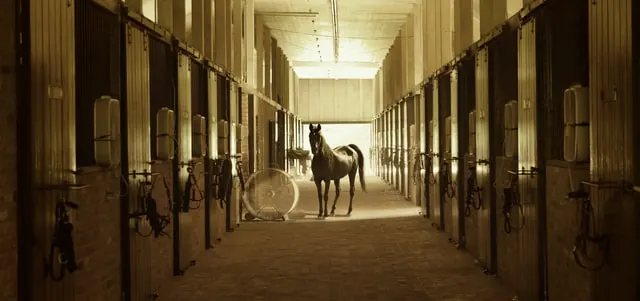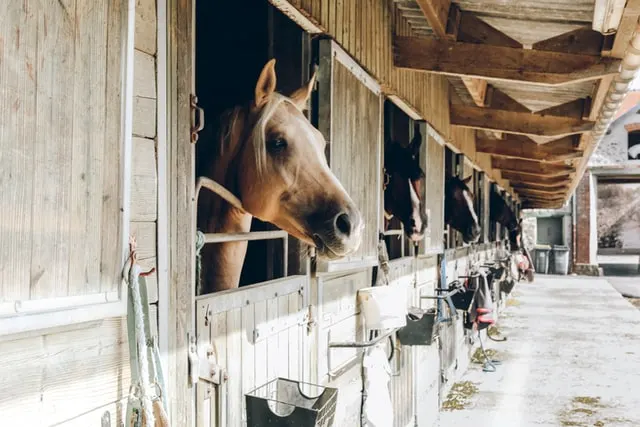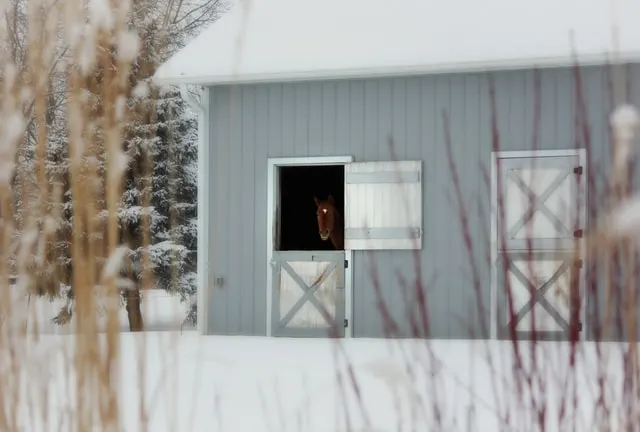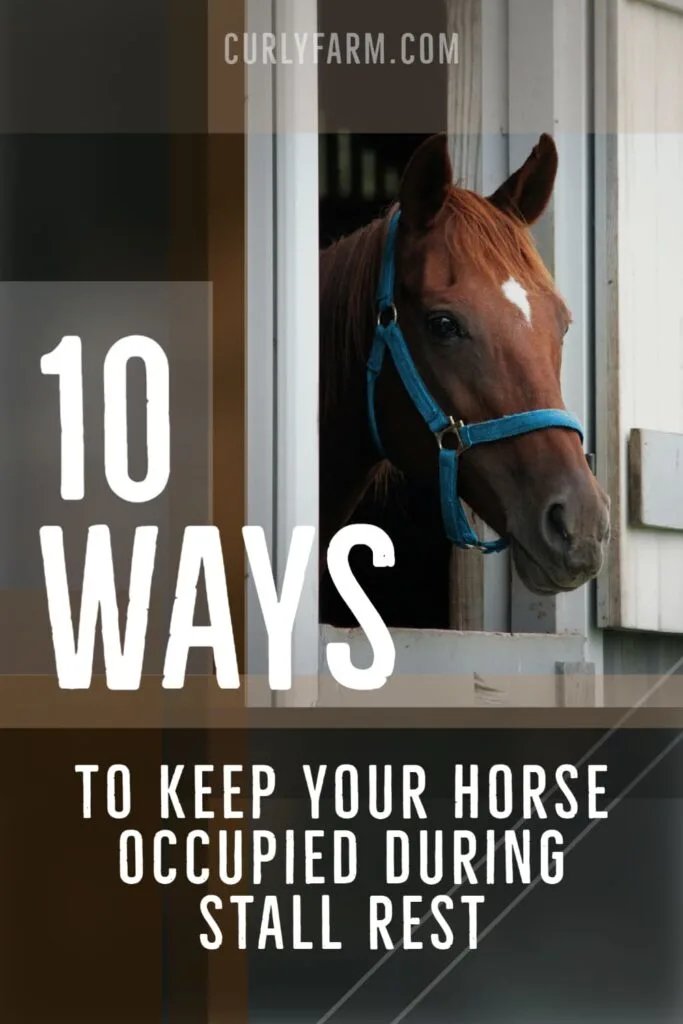Keeping a horse on stall rest can be stressful both for horses and for the humans who care for them. For some equine injuries, stall rest or partial stall rest is the only way to rest a horse’s body sufficiently for a full recovery.
For horses, whose brains and bodies evolved to range over many miles of land each day, stall rest is physically and psychologically very difficult. If your horse is on stall rest, part of your responsibility in helping them recover will be finding ways to keep your horse mentally occupied enough to keep them from overflowing with energy, climbing the walls of their stalls, and reinjuring themselves.
For some horses, this will require sedative medication, but many horses can handle stall rest with no sedatives – especially if sufficient mental stimulation and psychological care are provided. Below are 10 creative ways to provide that care for horses on stall rest to help them recover quickly without reinjury.

1. Begin clicker training useful tricks to keep your horse’s mind stimulated.
The following section may contain affiliate links. As an Amazon Associate, we earn from qualifying purchases.
Most horses are very food motivated, and this makes them extremely easy to train using clicker training. Clicker training is a popular training method for training all sorts of animals– but hasn’t reached peak popularity with horse owners. Thankfully, it’s easy to pick up how clicker training by watching a few YouTube videos or checking out a book on how to chain the behaviors to get your horse to do complex and impressive tricks on command.
Even the most complex horse tricks are just a series of tiny tricks chained together. Stall rest is an excellent opportunity to train your horse to respond to basic commands in a way that is fun, useful, or both. During stall rest, clicker training is a way to keep your horses mind occupied without straining their body. For example, even if your horse has a leg or hoof injury, you can train them to perk their ears on command, tuck their nose in on command for a cute photo, or even to “give you a hug” with their neck in response to a verbal or hand cue.

2. Begin a routine of gentle stretches to help maintain some muscle tone and burn some energy.
Even though your horse has veterinary orders to not move around outside of their stall, you can still provide some exercise for your horse via stretches. It’s best to consult with the veterinarian who has prescribed a stall rest for your horse regarding what stretches they would recommend. For example, manually stretching legs can be helpful, but not if increasing weight on the three resting legs is a concern.
For most horses during stall rest, neck, chest, and shoulder stretches are fine. Not all veterinarians are familiar with how manually stretching can benefit horses, so if your veterinarian doesn’t have feedback on this stall rest activity, check with a more holistic practitioner or a horse chiropractor.
Even though your horse is on stall rest, certain stretches can help them build muscle in the neck, back, and chest that will support increased performance when you get the all-clear to go back to riding regularly. Although it’s virtually impossible to wear out a horse on stall rest with just stretches, just like a weight lifting session or yoga class for humans, some energy can definitely be deflected through stretching.
Both the physical activity and the hands-on interaction with a handler during manual stretching can help horses cope with the stress of being on veterinary stall rest.
3. Buy or Build treat-puzzles for your horse to solve.
Food is one of the easiest ways to keep any horse occupied– and this is certainly true for horses on stall rest- but there can be too much of a good thing. Overfeeding has its own concerns during stall rest. To avoid overfeeding, consider distributing treats via a treat-dispensing horse toy.
Dozens of stimulating horse toys are available in tack shops and online. If purchasing treat-dispensing horse toys for your horse are not in your budget, consider making your own toys to help keep your horse occupied and interested- This can help reduce the chance of them developing vices or even potentially reinjuring themselves through boredom-motivated overexuberant activity inside their stall. For ideas on making your own horse toys, check out our Pinterest board on DIY horse toys.
4. Create a challenging slow-feeder for hay so your horse has something to do.
Similar to the horse toy idea above, simply stretching out your horses daily feeding in a way that requires the horse to problem solve or physically manipulate something in order to get their regular serving of hay can help fill more hours of stall rest with meaningful activity – something horses stuck in a stall appreciate. As long as they are foraging, horses are generally happy and not being destructive to themself or their stall

5. Get your horse a quiet buddy
Did you know that large barns often use small ponies as companions for anxiety-prone competition horses? When I visited the stable of olympian Isabella Werth, several of the million-dollar horses had tiny pony companions. These ponies, chosen for steadfastness and calm personalities, accompanied horses to and from turnout, and even to horse shows– pairing these high energy, high-value horses with slower, calmer, companions helped tone down anxiety and boredom-motivated behaviors in the show horses. Similarly, your horse may benefit from sharing their stall during stall rest with a pony or even a non-horse small animal. (You may also be interested in learning more tips for how to calm down an anxious horse.)
6. Keep other horses around
Horses kept alone in a barn experience much higher stress levels. When you have one horse on stall rest, never empty the barn and take all the other horses to pasture and leave your injured horse behind. Horses are herd animals, and even though your veterinarian has ordered your horse remain in the stall, your horse needs other horses nearby to communicate with in order to get through stall rest mentally sound.
If you typically turn your horses out during the day, switch up your schedule so your horse’s best buddy stays inside during the day to keep your horse on stall rest company, and turnout that horse overnight (with a buddy) when the other horses come in.
7. Maximize visual stimulation for stall rest horses
Although some highly excitable horses may do better in an environment with less stimulation, most horses will get through stall rest a little easier if they are able to see and communicate with other horses, humans, and general stable activity.
The ideal stall for most horses during stall rest is a small stall in a central part of the barn, with a good view of the busiest areas of the barn (like grooming stalls or an indoor arena entrance), and with a view outside the barn (more on that later), with bars rather than solid walls dividing it from other stalls. Make sure the horses on either side of your horse on stall rest are agreeable and calm horses. They will keep your horse company, minimize boredom, and help soothe your horse when stall rest has their frustration overflowing.
8. Maximize fresh air
Did you know that human patients in ICU wards recover up to 20% faster when their hospital room has a view of the world beyond the hospital? It’s true, recent research has found that even for unconscious individuals, being housed in a hospital room that has a view of sky, trees, or even a parking lot means they are more likely to recover. Why should animals evolved to range vast open spaces be any different? If your stalls don’t open to the outside, ask your veterinarian if outdoor stall rest in an area such as a section of round-pen or a fenced-off outdoor shed may be appropriate housing for your injured horse.
9. Keep a routine
We don’t really know much about horses’ sense of time passing or their ability to look forward to future events, but if you’ve ever been responsible for feeding horses you know that they have a sixth sense for knowing when it’s time for certain activities. Just like children who have lower stress levels when a routine is consistent and predictable, horses on stall rest may benefit from knowing when certain things may happen.
Hours and hours of stall rest with no end in sight can be mentally challenging for any horse, but if your horse has a sense throughout the day that there are regular things to look forward to, they may be able to mentally handle the stress of stall rest with just a little less stress and a bit better capacity to heal.
10. Groom regularly
Just like how horses groom one another to bond, grooming your horse is one way to care for their body and bone with them, even when your horses on stall rest. For all mammals, touch, grooming, and skin to skin (or skin to fur, or fur to fur!) contact releases hormones in our brain and body that soothe us and help us feel calmer.
Imagine how you feel when your dog chooses to lay with their weight on you, or when your cat gently kneads your lap. These same feel-good brain chemicals are released in horses’ brains when they get good grooming and good scratching- so don’t neglect grooming, pats, and snuggles during stall rest.
Even though your horse isn’t out rolling in the mud, regular grooming during this rehab period is important. As often as possible, give your horse a good grooming head to toe- grooming stimulates skin cells and helps increase blood flow through the body, which can aid in speeding recovery time from injuries.


